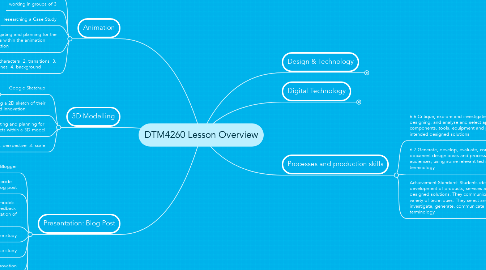DTM4260 Lesson Overview
by Sarah Leo


1. Animation
1.1. Pivot application
1.2. working in groups of 3
1.3. researching a Case Study
1.4. investigating and planning for the aspects within the animation production
1.5. 1. characters 2. transitions 3. scenes 4. background
2. Design & Technology
2.1. Definition
2.2. Items to be Delivered
2.3. Extent
2.3.1. Included
2.3.2. Included
2.3.3. Excluded
3. 3D Modelling
3.1. Google Sketchup
3.1.1. Project specifications
3.1.2. End User requirements
3.1.3. Action points sign-off
3.2. Designing a 2D sketch of their proposed innovation
3.2.1. Define actions as necessary
3.3. investigating and planning for the aspects within a 3D model
3.4. 1. rotation 2. perspective 3. scale
4. Presentation: Blog Post
4.1. Class blog page on Blogger
4.2. investigate other blog sites to decide on the criteria for an effective blog post
4.3. explore iDesign website to view other 3D models made on google Sketch up and provide feedback and evaluate the effectiveness and presentation of them
4.4. 1. description of case study
4.5. 2. animation video supporting case study
4.6. 3. 2D sketch of their innovation
4.7. 4. 3D model on Google Sketchup
5. Digital Technology
5.1. Budget
5.1.1. Materials
5.1.2. Personel
5.1.3. Services
5.1.4. Duration
5.2. Delivery Timeline
5.3. Requirements
6. Processes and production skills
6.1. 6.6 Critique, explore and investigate needs or opportunities for designing, and analyse and select appropriate materials, components, tools, equipment and processes to achieve intended designed solutions
6.1.1. Dependencies
6.1.2. Milestones
6.2. 6.7 Generate, develop, evaluate, communicate and document design ideas and processes for a range of audiences, using some relevant technical terminology
6.2.1. Schedule
6.2.2. Budget
6.3. Achievement Standard: Students identify key aspects of a design situation when considering the development of products, services and environments and establish criteria for the evaluation of designed solutions. They communicate, evaluate and modify creative design ideas using a variety of techniques. They select and use appropriate digital technologies to collaborate on, investigate, generate, communicate and document design ideas and processes using technical terminology.
6.3.1. KPI's

